We will be at the Little Falls Craft Fair Saturday and Sunday, September 10th and 11th. Stop by our booth located in front of the Good Book Bookstore.
renholland.com
We will be at the Little Falls Craft Fair Saturday and Sunday, September 10th and 11th. Stop by our booth located in front of the Good Book Bookstore.
renholland.com
My thanks to Cathy Brugger who contributed the following 1950s photos of Pine Cone Resort located on Kabekona Bay on Leech Lake.




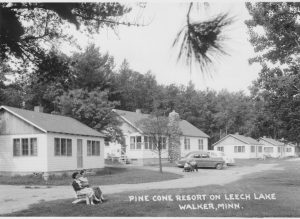
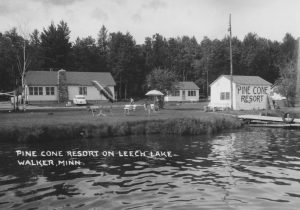
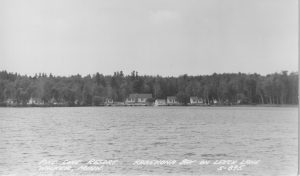
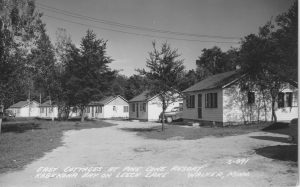 According to a 2006 Woodland Resort Newsletter, Pine Cone Resort was built about 1951. Owners in the 1950s were Margaret & J. W. Bunten, believed to be from from Kansas City. A 1956 mimeographed letter stated: “Pine Cone Resort is the newest in the vicinity, and one of the largest and most modern, with a lodge, store, and 16 modern cabins.” According to a 2006 Woodland Resort newsletter, Pine Cone may have been the last resort built on Kabekona Bay.
According to a 2006 Woodland Resort Newsletter, Pine Cone Resort was built about 1951. Owners in the 1950s were Margaret & J. W. Bunten, believed to be from from Kansas City. A 1956 mimeographed letter stated: “Pine Cone Resort is the newest in the vicinity, and one of the largest and most modern, with a lodge, store, and 16 modern cabins.” According to a 2006 Woodland Resort newsletter, Pine Cone may have been the last resort built on Kabekona Bay.
There were few accommodations available at Walker, Minnesota in 1896 when white travelers began to arrive on its first railroad. Camping was the main option for visitors, and a community of tents dotted a peninsula on the Leech Lake shoreline. Walker was still a small settlement composed of a rough and tumble mix of white lumberjacks, fur traders, and trappers.
The first significant hotel, the Pamida, was built by Patrick H. McGarry in 1897. The following year, a conflict occurred at Leech Lake between U. S. Army soldiers and the Ojibwe from the nearby Leech Lake Reservation. Six soldiers were killed in the Battle of Sugar Point. It is considered the last official battle of the Indian Wars. Walker became known as “the last frontier” and curious tourists arrived by train to visit the site.
Walker needed another hotel to handle a surge of visitors, hunters, and fishermen. McGarry capitalized on the event and in 1901 opened his second hotel, with cabins, on the peninsula that once contained campsites. He named it “Glengarry.” The hotel and cabins, were a success and hosted many dignitaries. It is considered the first resort on Leech Lake, and was the top resort on the lake until 1922 when Chase on the Lake was built.
A photo postcard mailed in 1912 to Oak Park, Illinois describes Glengarry and reflects a new, more refined image of Walker: “Dear Adelaide—I am having a fine time. There is a building next to us called the grand opera house . . . at present they are having moving pictures.” (click on image to the right to enlarge)
After the Glengarry closed it was abandoned and eventually succumbed to decay. It gradually disappeared, blending into the natural surroundings. In 2009, after 100 years under one family’s ownership, the 33 acre estate was subdivided into large lots. Only stone remnants of steps and chimneys remain to remind us of this historic era.
Please see more photos, history, and brochures of the Glengarry Hotel that were graciously donated to this website by Melanie Rice of Rice Creative Services, LLC in Walker. Click here to view them, or find them under “Shared Photos” tab, then select the “Leech Lake collection #2,” or use the “Search” tab on this website. More information about Glengarry can also be found in my book, The Early Resorts of Minnesota.
Fuller’s Fishing Contest in Park Rapids, Minnesota was probably the first major fishing contest in the state. It was certainly the longest running fishing contest, beginning in 1916 and lasting until 1985. The contest was sponsored by Fuller’s Tackle Shops with local resort support within a 25 mile area around Park Rapids and Grand Rapids, Minnesota.The video below, Catch a Memory, gives us a visual sample of the thousands of individuals who registered fish for this contest.
Most of the photos in Catch a Memory were taken by the contest’s founder Earl Fuller, or his son Jerome (Jerry). Their store was often the first place tourists would stop on their arrival to the Park Rapids area. Many of the largest contest fish were displayed daily on ice behind a large window on Main Avenue.
 In midwinter, contest entrants were mailed the highly anticipated Fuller’s Golden Book which listed each entrant’s name, prize, etc. (In Grand Rapids it was the Fuller’s Blue Book.) Of course, the books offered an opportunity to study resort advertising and plan for the next vacation. The Minnesota Department of Natural Resources still uses the Golden Book and Blue Book data for studying fish populations.
In midwinter, contest entrants were mailed the highly anticipated Fuller’s Golden Book which listed each entrant’s name, prize, etc. (In Grand Rapids it was the Fuller’s Blue Book.) Of course, the books offered an opportunity to study resort advertising and plan for the next vacation. The Minnesota Department of Natural Resources still uses the Golden Book and Blue Book data for studying fish populations.
Fishing contests have changed considerably since the days of Fuller’s Tackle Shops. Instead of a summer long contest, most of the contests today are one-day events. There are now over 400 fishing contests in Minnesota each year, with roughly three-fourths scheduled in summer and one-fourth in winter. Prize money can reach over $100,000, with the highest amounts in winter contests. Brainerd, Minnesota is recognized as having the world’s largest ice fishing contest, raising $1-million in revenue for area businesses and donating over $150,000 to area charities each year.
Today, attitudes and rules have changed toward catching large fish. Contests too, have changed. We no longer see huge fish displayed in sidewalk windows. Contests last only a day. Catch and release photos and tape measures are emphasized, with slot limits regulating the size we keep. We return the big ones to the water. Duplicates are made of fiberglass, as found in the state record fish on the walls of the Minnesota Fishing Museum at Little Falls, Minnesota.
Fishing contests and fishing rules have changed. Our attitudes have changed. But we all can still have a dream of catching that monster fish, or at least having something for the frying pan.
To read my earlier blogpost about Fuller’s Tackle Shop, click here.
 Last year I entered my book The Early Resorts of Minnesota in a writing contest sponsored by Writer’s Digest Magazine. Over 2,300 books were entered in “The 26th Annual Writer’s Digest Self-Published Book Awards.” My book was published in 2012, just making the timeline for entries. While it was not selected as a prize winner, I was pleased with the high ratings and a judges’ positive commentary.
Last year I entered my book The Early Resorts of Minnesota in a writing contest sponsored by Writer’s Digest Magazine. Over 2,300 books were entered in “The 26th Annual Writer’s Digest Self-Published Book Awards.” My book was published in 2012, just making the timeline for entries. While it was not selected as a prize winner, I was pleased with the high ratings and a judges’ positive commentary.
Books are evaluated on a scale of 1 to 5, with 1 meaning “needs improvement” and 5 meaning “outstanding.” My book’s scores were as follows:
Plot and Story and Character Appeal and Development were not applicable in the Nonfiction category for judging my book.
The Judge’s Commentary:
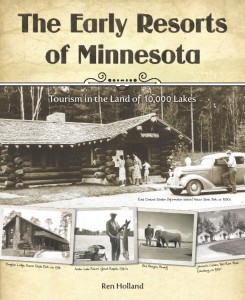 The Early Resorts of Minnesota
The Early Resorts of Minnesota
by Ren Holland
Congratulations on writing and publishing your book! The packaging is extremely professional, and I appreciate the care and expense you have taken to make this a hardcover keepsake and reference with so many historical photographs that are so clearly reproduced. The cover design is eye-catching and does a great job of highlighting the book’s purpose and potential audience. This book will have a wide potential audience, from Minnesotans in general to those in the tourist industry, historians, and others looking for a reference guide to find specific information. You have clearly done a great deal of research and you have presented the information in a reader friendly manner. Your writing style is conversational and enjoyable without taking focus away from the historical details. The book is well organized and easy to navigate. I appreciate the inclusion of your detailed Index as well. The many photographs you included help to bring these places to life. Good job with grammar and proofreading. The formatting of the text and layout of the pages are quite effective. You have an excellent web site to market your book, speaking engagements, etc.
 The 46th annual Little Falls Arts and Crafts Fair attracted its usual large crowd, estimated at around 100,000, including crafters, artisans, antique collectors, and classic car owners.
The 46th annual Little Falls Arts and Crafts Fair attracted its usual large crowd, estimated at around 100,000, including crafters, artisans, antique collectors, and classic car owners.
Seven authors and I were invited by Marge Krinke of The Good Book and Gift Store to display our books and talk to those who passed in front of the store on First Avenue. It was an opportunity to publicize The Early Resorts of Minnesota and The Edge of Itasca and to meet some of the many who passed in pursuit of special craft items.
I wish to thank Marge for the invitation, and also my daughter Renee, who assisted me. Included here are a few photos of the authors and crowd.
I want to thank Tim Donohue for sending photos taken at Big Whitefish Bay Resort during the summers of 1963-64, when he was a young boy. Tim’s sister, Jane, worked at the resort and they both share fond memories and images of the resort and the people they met. It was operated at that time by Audrey Ternus (1908-1991). Tim has also included a detailed description of the resort.
One of Tim’s memories describe a man in an old wooden inboard who delivered mail and gave free rides to kids along his route. Although Tim may not have known it at the time, this would have been the legendary mailman, Ben Knebel, who delivered mail to Whitefish Lake residents from 1930 to 1969. If you look at Figure H, you will see the mailboat docked at Big Whitefish Bay in 1963. In 1992, over twenty years after Ben died, his 1949 mahogany 22 foot Chris Craft Sportsman boat was discovered after a long search. It was extremely deteriorated, but with personal affection, it was meticulously restored by two Whitefish Lake Resorters, Joe Ruttger and Ron Schultz.
I have not seen this historic boat, but look forward to finding it next summer. Information may be available at the Crosslake Historical Society.
We can all appreciate that Tim and Jane donated these photos and information, which give us a historic glimpse of Big Whitefish Bay Resort and Ben Knebel’s cherished mailboat.
To read Tim’s writeup and view all of Tim and Jane’s donated photos, click here.
On March 10, 2018, I spoke to the Brainerd, Minnesota chapter of the Captain Robert Orr National Society Daughters of the American Revolution (DAR). Before my slide presentation, I brushed up on the goals of the DAR on their website and found that the chapter is one of 3,000 nationally and internationally. Any woman 18 years or older, regardless of race, religion, or ethnic background, who can prove lineal descent from a patriot of the American Revolution is eligible for membership in the DAR. Its broad goals include historical preservation, promotion of education, and encouragement of patriotic endeavor. Members participate in a variety of projects to help preserve our cultural heritage.
I was invited by member Kathy Brown, who, with her husband Russ, traveled from Park Rapids to attend the chapter’s luncheon meeting at the Sawmill Inn at Brainerd. My slide presentation was titled “Early Central Minnesota Resorts and Tourism.” I’ll touch on a few of the subjects covered, some of which are in my book, The Early Resorts of Minnesota.
Brainerd Area Lakes tourism blossomed with the advancement of automobiles and highways in the 1920s. However, the city of Brainerd owes its existence to a decision made back in 1870 by the Northern Pacific Railroad when it surveyed the first east-west transcontinental route across the northern states. At that time, just about everyone expected the tracks to cross the Mississippi River at the village of Crow Wing, a traditional crossing point and the largest village along the northern Mississippi. However, the decision was made to cross seven miles north of Crow Wing! This spelled doom to the village’s future, as everyone migrated to seek opportunities in the brand new village of Brainerd, named after Ann Eliza Brainerd’s family. She was an American author, Civil War patriot, and wife of the railroad’s president, former Vermont Governor, J. Gregory Smith.
Travel and curiosity followed the newly constructed railroad tracks, which started near Duluth (completed in 1883). Fishing the new lakes along the route drew national travelers to Bay Lake, near Deerwood. The Ruttger family had settled there, and what began as a homestead, developed into a long history of resorts. As many as five resorts had the Ruttger name at one time. Ruttger’s at Bay Lake may be the earliest resort in northern Minnesota (1894), with the exception of Lutsen Resort on Lake Superior. Ruttger’s Bay Lake Lodge certainly must be the oldest resort operated by relatives of one family.
Names of resorts in Minnesota were not recorded until about 1915. Hotels were mixed in the count. Below are the first resorts in Crow Wing County (Hotels are not included.)
At Brainerd: Hough’s Resort on Gull (C. M. Hough), Hubert Cottages (C. M. Palek), Parkerville Cottages (F. S. Parker), South Long Lake Resort (Wm. McCall).
At Deerwood: Highland Resort, Miller’s (A. A. Miller), Ruttger’s Tourist’s Home at Bay Lake (Joseph Ruttger).
At Hubert: Heals Cottages (B. C. Heals), Minnewawa Lodge (B.C. Heald), Osborne Cottages (L. L.Osborne), Pukwana Lodge (W. D. Curtis), Wasena Camp (Sol Marquis & Son) on Pelican Lake.
At Jenkins: Hardy Camp on Whitefish (Dave Hardy), Lakeside Camp, Piney Ridge (F. W. Palmer), Shady Rest Camp.
At Merrifield: Velvet Beach on Big Pelican (Ike Miller).
At Nisswa: Grand View on Gull (Baker-Seaton Co. of Mpls.), Ozonite Resort on Gull (S. V.Long), Rocky Point Resort on Gull.
At Pequot: Kamberling Resort (Chas. Kamberling) on Whitefish, Shady Nest Camp (O. L. Thomas), Silver Peak Lodge ( J. A. McEwen) on Whitefish.
Of those mentioned above, only two have retained their original names—Ruttger’s on Bay Lake, and Grand View, on Gull (click here to read my “Blue Ribbon Resort” write-up on Grand View). These, and later resorts in the Brainerd Lakes Area, have become nationally and internationally known for their broad range of deluxe facilities for convention guests and tourists.
I want to thank the Brainerd DAR chapter for the opportunity to speak about early resort history in the Brainerd Lakes Area.